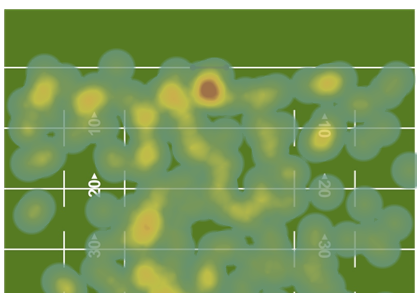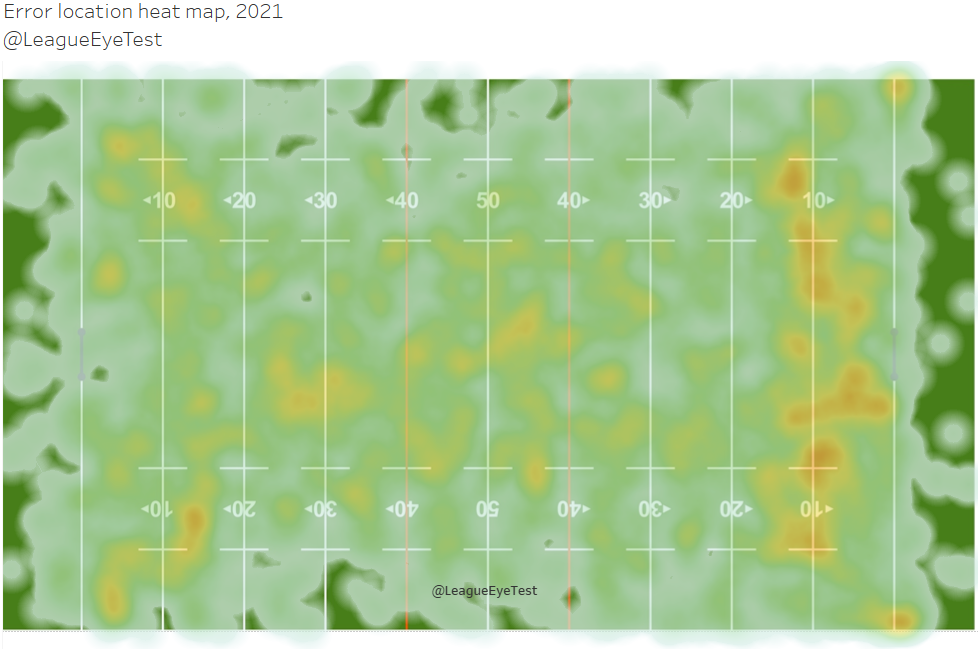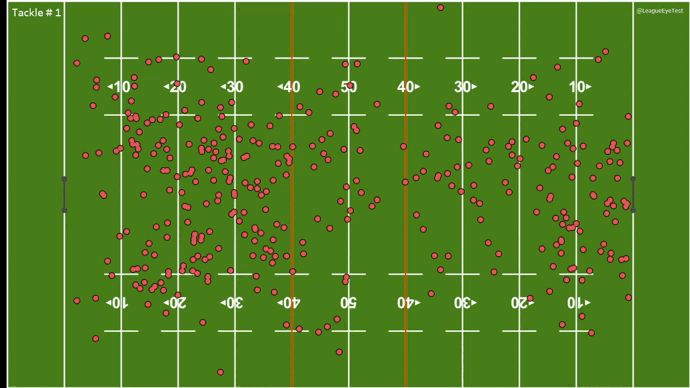Most of the NRL media appears to be writing obituaries for South Sydney’s 2024 campaign this week. And to a lesser extent the Titans, although they never had any real hope of competing this year to begin with.
I’m not going to join them as I’ve got very little to add on from last week’s post. It was very clear that both sides fell into the “incompetent” quadrant of my efficiency charts, although incompetent may have been too nice given their respective performances in Round 5. Maybe I need a new descriptor for sides as abysmal as Souths and the Gold Coast?
Anyway, we knew they were very bad, and very bad they were. The Titans were so incompetent that I didn’t even notice they were missing from my attack efficiency chart last week, because they’d only scored an average of six points per game and were outside of my axis ranges.
First up, a big thanks to Fonzie of This Warriors Life podcast, who not only pointed it out but also had some amazingly kind words to say about last weeks post and how to interpret that data. If you haven’t checked out their podcast, I’d highly recommend it, even more so if you’re a decking aficionado.
The only thing that might take some of the heat off the Bunnies and Titans was just how diabolical the Eels were in losing 41-8 to Canberra. They looked sluggish across the park and let the Raiders run up a score despite some average field position, as seen in the expected point chart below.

The Eels had enough field position to win the game, but were unable to stop Canberra from running in long range tries. This from a team that looked dominant a few weeks ago against Penrith. Losing Mitch Moses definitely hurts, but that shouldn’t cause a substantial breakdown in defense as we’ve seen from the Eels. Just like Souths continual defensive breakdowns had nothing to with Lachlan Ilias. But I digress.
So, if we’re not examining the woes of Souths or the Gold Coast, what are we looking at this week?
Well, it’s time for another important Eye Test investigation – who is the straightest ball runner in the NRL?
Is this important data that is going to help sides win football games? No. Is this one of those brainworms that will envelop me if I don’t have the question answered? Yes. So I’m getting it out of the way early this season to avoid later distractions.
Part of it was because I already have the data for this from my expected run metres model, so I thought I’d put it to use in another way. Using a similar approach to the general play kick spray charts that I debuted earlier in the season, I’ve calculated the angle of each run based on the starting and ending positions of each run. From there we can see which players have the lowest average run angle, and therefore are running straighter.
It’s not a perfect way of measuring the straightest runners, as the direction of a run can be dictated by many things like field position, the angle or speed of a pass and the composition of the defensive line. Running direction can also be impacted by a players role, the style of play they have and the structure a coach wants to use. Still, it’s a good proxy for determining who runs the straightest in the competition.
So just who is the straightest runner in the NRL? Here’s the top 20 straightest runners since 2021, including up to Round 5 2024.
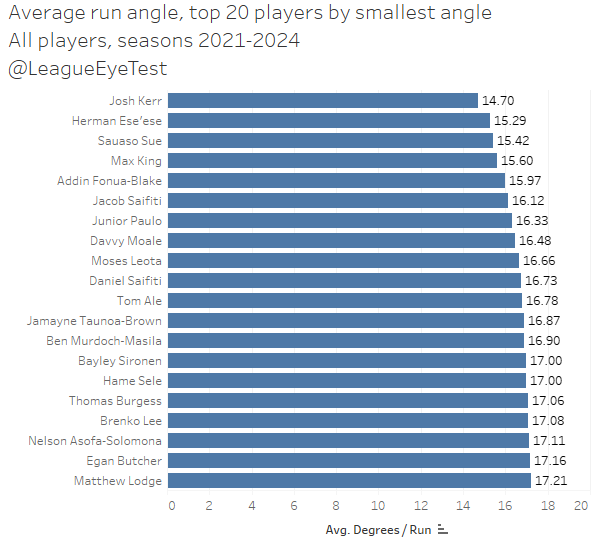
The straightest runner in the NRL is THE Dolphins forward Josh Kerr, at an average of 14.70 degrees per runs. He’s the only player in the NRL since 2021 with more than 150 runs and a run angle of less than 15 degrees.
Kerr has made regular appearances on the Eye Test’s advanced stats like Tackle % and Ball Runner Rate, as one of the harder working forwards in the competition. He’s managed to pop up again this week in first place for Involvement Rate and in fifth spot for Ball Runner Rate.


Second place goes to another (former) Dolphin, the recently departed Herman Ese’ese, who ran at an angle of 15.29 degrees. Third place over the past few seasons was Suaso Sue, at 15.42 degrees. The last two spots in the top five go to Bulldogs prop Max King (15.60 degrees) and Warriors star Addin Fonua-Blake (15.97). These five players are the only ones under 16 degrees per run.
These numbers are also for multiple seasons, so I thought I’d break them down by individual seasons to see if there was a trend there.
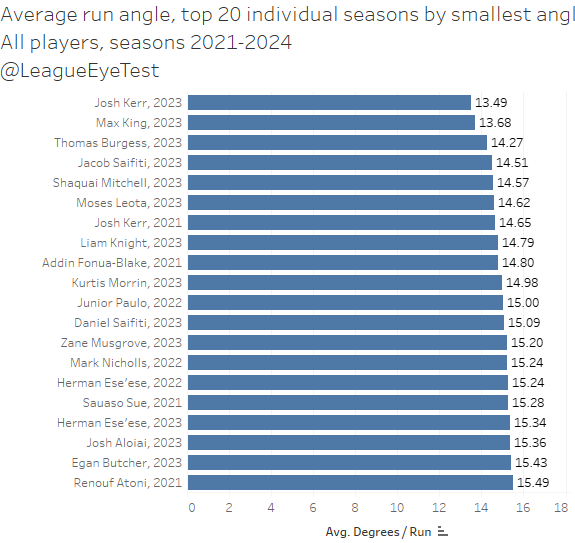
Looking at individual seasons, Kerr has dominated this metric. He has two of the top seven seasons with the smallest run angles – just 13.49 degrees in 2021 with the Dragons and 14.65 during 2023 when he split time with the Red V and the Fins.
Canterbury’s King had a run angle of 13.68 degrees in 2023 and would have been first overall if I’d limited the number of runs to 200 or more. King also had his 2022 season inside the top 20 with an angle of 16.12 degree per run. Third place for individual seasons goes to Tom Burgess, whose impressive 2023 was fuelled by a run angle of just 14.27. His 2024 campaign thus far is seeing him run at an angle of 14.53 degrees, indicating he could take top spot again for 2024.
You’ll notice these are mostly middle forwards, which is what I’d expect. Just out of curiosity, I’ve filtered the same data for backs only, and here’s the results.
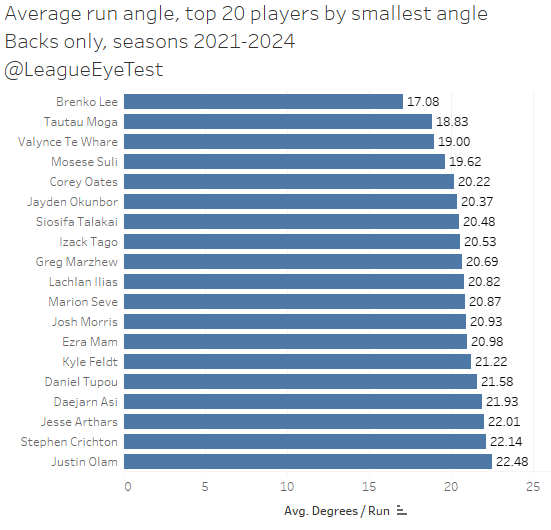
It’s another win for the Fins, with Brenko Lee topping the chart here, which should have been obvious as we saw him inside the overall top 20 above. Talatau Moga was the second highest back at 18.83 degrees and another Dolphin fan favourite in Valynce Te Whare was next, with a run angle of 19 degrees, which placed him 54th overall. Moses Suli is fourth, at 19.77 degrees and Corey Oates rounded out the top five at 20.22 degrees. Oates placed 103 overall since 2021, meaning just five backs cracked the top 100.
The highest individual season by a back was Brenko Lee again at 15.94 degrees for his 2023 season.
And as you know, we always like to look at the other end of the scale at the Eye Test. Who has the biggest run angle?
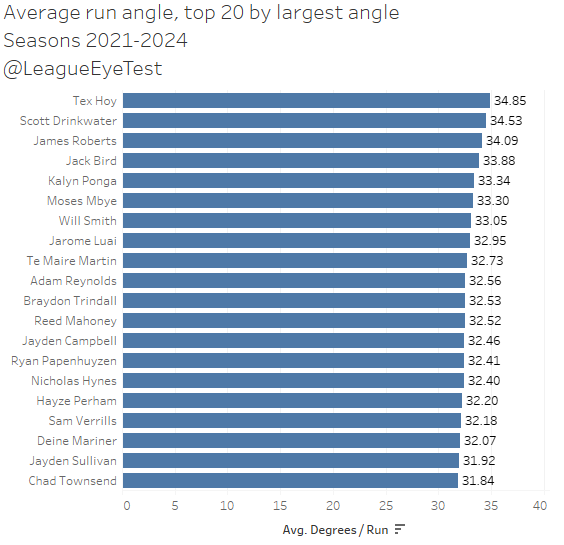
Tex Hoy takes the crown here, running at an average of 34.85 degrees per run. Scott Drinkwater takes the crown for current NRL players at an angle of 34.53 and James Roberts was third at 34.09. Most of this list is from halves or fullbacks trying to run wide to create space and gaps for edge players running straighter lines, or halves who have also spent some time at dummy half like Moses M’Bye, Will Smith or Ben Hunt.
For individual seasons by a back, George Williams in 2021 had the widest run angle at nearly 40 degrees per run ahead of Tex Hoy’s 2021 at 38.6, and Kayln Ponga’s 2021 at 37.34.
One name who usually comes up as one of the straightest ball runners in the NRL, Penrith’s Liam Martin, comes in at 23rd position with a run angle of 17.61 degrees. That’s an incredibly low number for an edge forward in a list dominated by middles. Here is the run spray chart for Martin, where we map every run angle and length assuming they started at the same point.
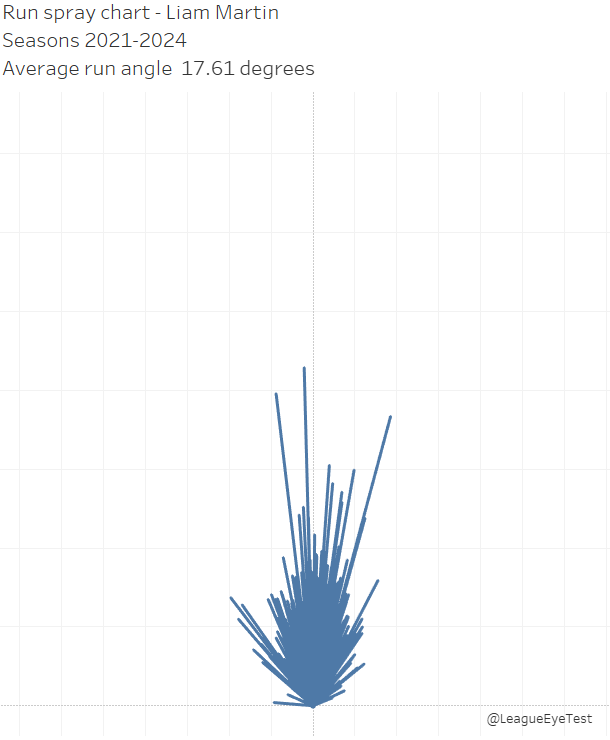
Unsurprisingly for a right edge player, most of his runs veer right and that’s where he’s had a lot of success, straightening up as the Panthers attack pushes wide. But he also has a high proportion of runs against the grain for an edge forward, although some of that is muddied by time off the bench in 2021.
However, compare the above chart with other backrowers like Viliame Kikau and Briton Nikora, you can see the slight difference in width for those players compared to how much straighter Martin runs.
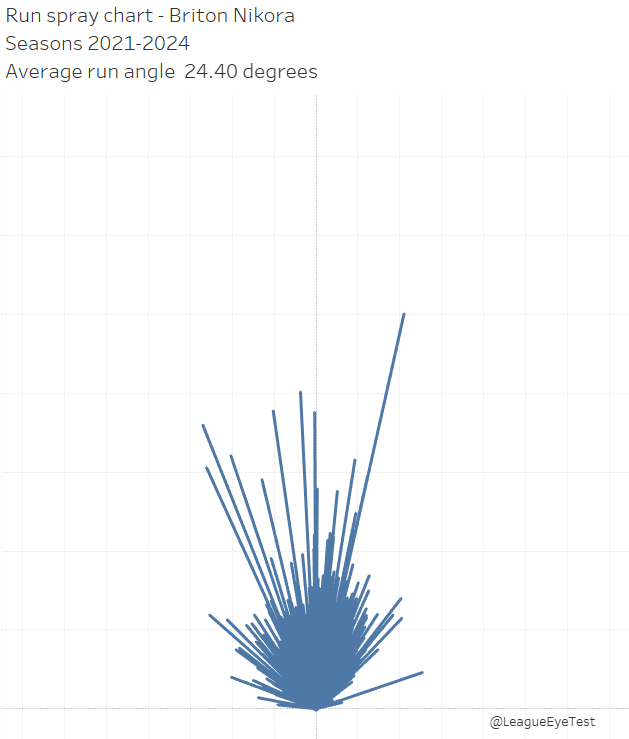
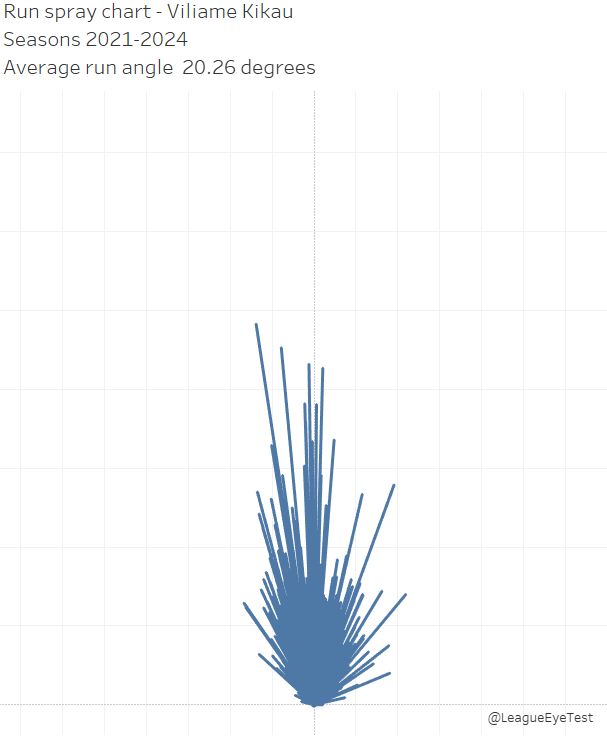
Unlike Martin, both players rarely head back inside on an opposite angle, instead focusing nearly all of their runs further to the direction of the edge they’re playing on. Again, this is largely due to role and playing shape or structure, but it’s still interesting to see it visualised this way.
Lastly, I’ve also decided to check which teams have the straightest runners and which teams have the widest runners.
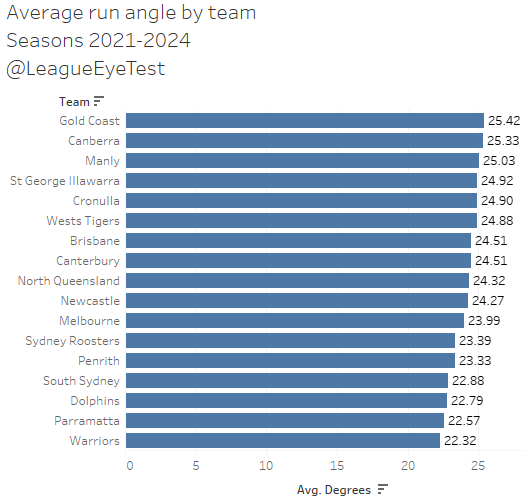
The Warriors run the narrowest, at an average run angle of 22.3 degrees per run since 2021. Parramatta are also extremely straight runners at 22.6 degrees, while the Dolphins aren’t much different, at 22.6 per run. South Sydney at 22.8 are the only other team below 23 degrees.
The Titans have the widest run angle, at 25.4 degrees, slightly ahead of Canberra at 25.3 and Manly at 25.0. These three are the only ones above an average angle of 25 degrees per run.
If we look at this by opponent, it’s a different story.
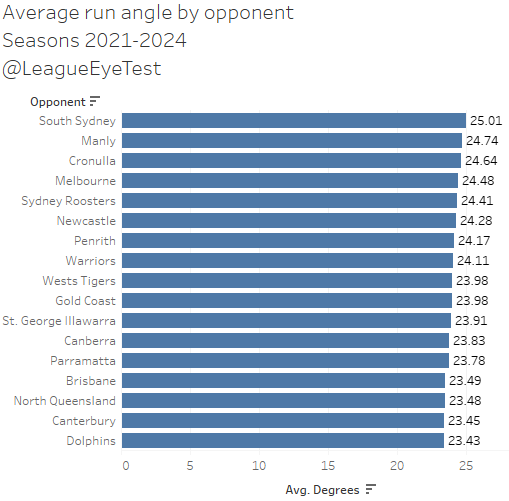
South Sydney allow the widest run angle at 25.0 per run, ahead of Manly (24.7) and Cronulla (24.6). The Dolphins allow the narrowest runs, at just 23.4 degrees, with North Queensland and Canterbury also allowing a very similar angle.
To finish up this week we’ll look at Run Metres Over Expected per run (RMOE/run) and the Eye Test Player Contribution Rating (ETPCR) to see who were the standout players this week.
First up we have RMOE/run for round five from a minimum of seven completed runs.

Kikau took first place here, at an astonishing 13.8 metres over expected per run, most of which came in the first half as the Dogs ambushed the Roosters on Friday evening. Manly flier Tolatau Koula was second at +9.17 RMOE/run in Manly’s win over Penrith, with Brisbane half Ezra Mam placing third at 8.01 RMOE/run.
And now the top 20 and bottom 20 players for the week by ETPCR.
As you’d expect, there’s plenty of Raiders players after their demolition of Parramatta on Sunday night, but three tries to Matt Burton against the Roosters secured him top spot, with an ETPCR of +5.608. Second place went to Shaun Johnson at +5.146 and third place to Scott Drinkwater at +4.804.
For those asking where Wayde Egan was, he sat in 23rd place at +2.353. For those asking Dylan Brown ranked 215th with an ETPCR of -1.294. Yet both received 1 Dally M vote. The system is broken beyond belief.
Drinkwater turned things around after placing last in ETPCR for Round 4, and was in incredible form on Sunday as the Cowboys beat the Titans, Despite the close scoreline for a Gold Coast game, was never that close, and the expected point chart for the game shows this.

Now here’s the bottom 20 players by ETPCR.

Dragons fullback Tyrell Sloan ended up with the lowest ETPCR for the round at -6.925 from his game against the Knights in atrocious conditions. Dom Young’s send off didn’t help him on the way to an ETPCR of -5.123 and Izack Tago had an abnormally bad game, placing third last at -4.093.
Considering the huge scores they gave up it’s surprising to see only a handful of Bunnies in this list and not near the bottom. That’s because the misery was shared all around – whilst they don’t make up most of the bottom 20 by ETPCR, they make up almost all of spots 20-40.

